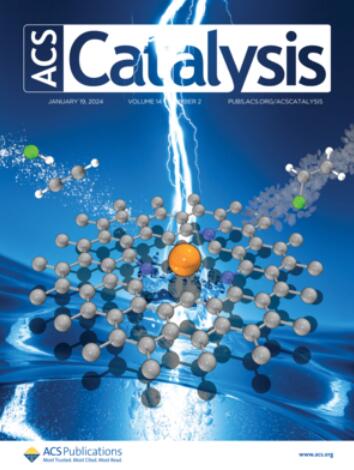Reaction-Driven Varieties of Active Sites on Cu(100) in Electrochemical CO2 Reduction Reaction
IF 11.3
1区 化学
Q1 CHEMISTRY, PHYSICAL
引用次数: 0
Abstract
The development of electrochemical CO2 reduction reaction (eCO2RR) on Cu-based electrodes is one of the promising strategies for environmentally friendly progress. Recent experimental findings have shown that the low-index single-crystal Cu surfaces undergo significant reconstruction by CO as reactants/products, greatly affecting their catalytic activity. It is crucial to understand how the reconstruction takes place in real time and affects the catalytic performance at atomic scale. Herein, we conducted a systematic investigation on the surface reconstruction of Cu(100) and its influence on eCO2RR using potential-dependent grand canonical Monte Carlo (GCMC), environmental kinetic Monte Carlo (EKMC), and density functional theory (DFT) methods. At the experimental onset potential of CO formation, we elucidate the atomistic mechanism of surface reconstruction under CO and H coadsorption. Adsorbate-driven formation of adatoms and vacancies appears on the surface first, and then square-like clusters are generated via the adatom aggregation. The reconstructed surfaces are identified to be stable for a long time (over hours) at a wide range of electrode potentials, which enhances the catalytic activity. Moreover, the formation of products shows an ensemble effect: Surface Cu atom vacancy is the most favorable for the formation of methane; adatom is the most favorable for the formation of hydrogen and formic acid; and 4-atom cluster is the most favorable for the formation of CO and C2 products. These results highlight the possibility of tuning the ensemble of reaction-driven species to enhance eCO2RR selectivity on the Cu(100) surface.

求助全文
约1分钟内获得全文
求助全文
来源期刊

ACS Catalysis
CHEMISTRY, PHYSICAL-
CiteScore
20.80
自引率
6.20%
发文量
1253
审稿时长
1.5 months
期刊介绍:
ACS Catalysis is an esteemed journal that publishes original research in the fields of heterogeneous catalysis, molecular catalysis, and biocatalysis. It offers broad coverage across diverse areas such as life sciences, organometallics and synthesis, photochemistry and electrochemistry, drug discovery and synthesis, materials science, environmental protection, polymer discovery and synthesis, and energy and fuels.
The scope of the journal is to showcase innovative work in various aspects of catalysis. This includes new reactions and novel synthetic approaches utilizing known catalysts, the discovery or modification of new catalysts, elucidation of catalytic mechanisms through cutting-edge investigations, practical enhancements of existing processes, as well as conceptual advances in the field. Contributions to ACS Catalysis can encompass both experimental and theoretical research focused on catalytic molecules, macromolecules, and materials that exhibit catalytic turnover.
 求助内容:
求助内容: 应助结果提醒方式:
应助结果提醒方式:


